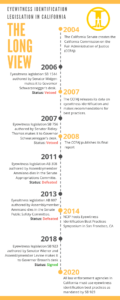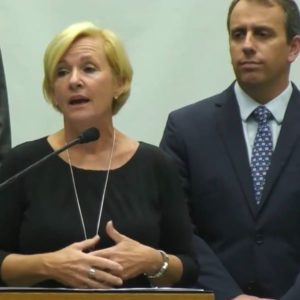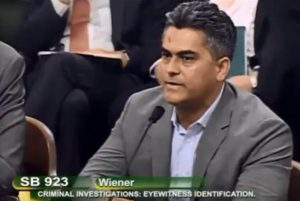In all our work, we must always take the long view. Our cases take years, sometimes decades to resolve, and involve hundreds of hours of investigation, meetings with dozens of witnesses, and the filing of multiple pleadings. When we lose in one court, we proceed to the next, and we don’t give up until justice is served.
We can say the same of our policy efforts. This year, Governor Brown signed Senate Bill (SB) 923, landmark legislation which mandates law enforcement’s use of best practices when conducting live or photo lineups, which will significantly reduce misidentifications in California. The bill mandates consistency between all law enforcement agencies in California and requires them to adhere to the following practices:
1) The investigator conducting the identification procedure shall use blind administration or blinded administration during the identification procedure.
2) An identification procedure shall be composed so that the fillers generally fit the eyewitness’ description of the perpetrator.
3) An eyewitness shall be instructed of the following, prior to any identification procedure: a) the perpetrator may or may not be among the persons in the identification procedure, b) the eyewitness should not feel compelled to make an identification, and c) an identification or failure to make an identification will not end the investigation.
4) The investigator shall immediately inquire as to the eyewitness’ confidence level in the accuracy of the identification and record in writing, verbatim, what the eyewitness says.
5) An electronic recording shall be made that includes both audio and visual representations of the identification procedures. When it is not feasible to make a recording with both audio and visual representations, audio recording may be used.
A number of people played key roles in getting SB 923 to Governor Brown’s desk. The bill’s co-authors, Senator Scott Wiener (San Francisco) and Assemblymember Marc Levine (Marin/Sonoma), did an amazing job championing the bill through both sides of the California legislature. Our co-sponsors of the bill, including the ACLU, the California Innocence Project and Loyola Project for the Innocent, were great partners in educating the legislature about the importance of passing this bill.
However, the people whose lives have been directly impacted by wrongful conviction were, and continue to be, our greatest difference-makers and voices of the movement. To help push this bill forward, criminal justice reform activist Jennifer Thompson presented to legislators about her experience as a crime victim having misidentified an innocent man.
NCIP exoneree Franky Carrillo gave moving testimony before the Assembly Public Safety Committee meeting. Franky was misidentified when he was just 16 years old and as a result, spent 20 years in prison for a murder he did not commit.
Additionally, a number of NCIP exonerees including Maurice Caldwell and Obie Anthony, whose cases involved misidentifications, worked behind the scenes to share their stories and educate lawmakers about how their experience with wrongful conviction supports the need for reform.
But 2018’s victory was preceded by years of work by many others, a series of losses, and determination to try again.
The California legislature first attempted to address eyewitness misidentifications 12 years ago in 2006 when Senator Carol Midgen introduced SB 1544 which called for the development and implementation of eyewitness identification (EWID) best practices. NCIP contributed to this initial effort, meeting with the senator in her office and helping craft language for the bill. Although that first bill passed through the legislature and eventually landed on Governor Schwarzenegger’s desk, he vetoed it claiming that the standards that would be developed lacked clarity.

In 2007, the California Commission on the Fair Administration of Justice (CCFAJ), created by the Senate in 2004, released their data and recommendations on eyewitness misidentifications. The commission’s mandate was to “study and review the administration of criminal justice in California to determine the extent to which that process has failed in the past” and to examine safeguards and improvements. NCIP co-founder and former executive director Cookie Ridolfi was appointed by the Senate and served as a commissioner on the CCFAJ. Eyewitness misidentification was one of the first topics of focus for the commission. The commission’s research outlined key evidence-based recommendations for statewide EWID procedures.
Also in 2007, the California legislature again attempted to address eyewitness misidentification by introducing SB 756, which incorporated the CCFAJ’s recommendations. Again, the bill passed through the legislature with NCIP supporting the effort, and arrived on Governor Schwarzenegger’s desk. And again, the governor vetoed the bill this time calling the CCFAJ’s recommendations “questionable” and asserting “law enforcement agencies must have the authority to develop investigative policies and procedures that they can mold to their own unique local conditions and logistical circumstances rather than be restricted to methods created that may make sense from a broad statewide perspective.”
In 2011 and 2013, California Assemblymember Tom Ammiano authored two additional bills, Assembly Bill (AB) 308 and AB 807, regarding EWID. Both bills died in the Senate.
As neither the legislature nor the Governor’s office was willing to pass and sign EWID legislation, NCIP turned to a new strategy – educating the law enforcement community with the goal of getting counties and individual departments to voluntarily adopt EWID best practices. With help from local law enforcement including former Los Gatos/Monte Sereno Police Chief Scott Seaman and Santa Clara County District Attorney Jeff Rosen, NCIP met with police chiefs, sheriffs, and district attorneys throughout the Bay Area to discuss adoption of these best practices. In 2014, NCIP hosted an Eyewitness Identification Best Practices Symposium in San Francisco, as well as other trainings throughout the Bay Area. Over the next several years, a number of law enforcement agencies in counties in the Bay Area joined Santa Clara Country in voluntarily adopting best practices, including San Francisco, Alameda, Contra Costa, and San Mateo.
By 2018, despite this progress, many of the larger counties were still resisting adoption of best practices. So the California Innocence Coalition (NCIP, the California Innocence Project, and Loyola Project for the Innocent) decided that it was once again time to seek legislation.
And on September 30, 2018 Governor Brown signed SB 923 into law. Over 30 years of solid social science support the CCFAJ’s recommendations which were ultimately included in SB 923. Twenty-one other states across the country have implemented these practices to reduce wrongful convictions and increase public safety.
When the bill goes into effect on January 1, 2020, it will mark 14 years since NCIP first dedicated itself to passing EWID reform legislation in California. Taking the long view requires time, patience, and persistence, but in the end, justice prevails.

